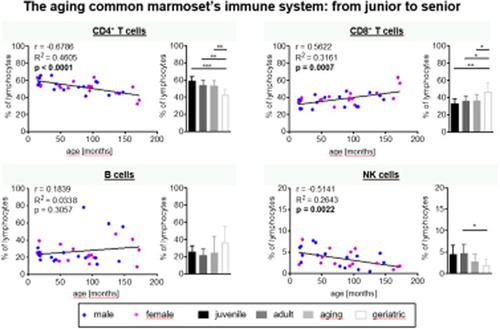当前位置:
X-MOL 学术
›
Am. J. Primatol.
›
论文详情
Our official English website, www.x-mol.net, welcomes your
feedback! (Note: you will need to create a separate account there.)
The aging common marmoset's immune system: From junior to senior.
American Journal of Primatology ( IF 2.0 ) Pub Date : 2020-04-04 , DOI: 10.1002/ajp.23128 Matthias Mietsch 1, 2 , Kristina Paqué 1 , Charis Drummer 3 , Christiane Stahl-Hennig 1 , Berit Roshani 1
American Journal of Primatology ( IF 2.0 ) Pub Date : 2020-04-04 , DOI: 10.1002/ajp.23128 Matthias Mietsch 1, 2 , Kristina Paqué 1 , Charis Drummer 3 , Christiane Stahl-Hennig 1 , Berit Roshani 1
Affiliation

|
The social, health, and economic challenges of a steadily increasing aging population demand the use of appropriate translational animal models to address questions like healthy aging, vaccination strategies, or potential interventions during the aging process. Due to their genetic proximity to humans, especially nonhuman primates (NHPs) with a relatively short generation period compared to humans, qualify as excellent animal models for these purposes. The use of common marmosets (Callithrix jacchus) in gerontology research steadily increased over the last decades, yet important information about their aging parameters are still missing. We therefore aimed to characterize their aging immune system by comprehensive flow cytometric phenotyping of blood immune cells from juvenile, adult, aging, and geriatric animals. Aged and geriatric animals displayed clear signs of immunosenescence. A decline in CD4/CD8 ratio, increased expression of HLA-DR and PD-1, higher frequencies of CD95+ memory cells, alterations in cytokine secretion, and a decline in the proliferative capacity proved T cell senescence in aging marmosets. Also, the B cell compartment was affected by age-related changes: while overall B cell numbers remained stable with advancing age, expression of the activation marker CD80 increased and immunoglobulin M expression decreased. Interestingly, marmoset B cell memory subset distribution rather mirrored the human situation than that of other NHP. CD21+ CD27- naïve B cell frequencies decreased while those of CD21- CD27- tissue memory B cells increased with age. Furthermore, frequencies and numbers of NK cells as part of the innate immune system declined with advancing age. Thus, the observed immunological changes in common marmosets over their life span revealed several similarities to age-related changes in humans and encourages further studies to strengthen the common marmoset as a potential aging model.
中文翻译:

普通mar猴的免疫系统:从初级到高级。
稳定增长的老龄化的社会,健康和经济挑战要求使用适当的转化动物模型来解决诸如健康老龄化,疫苗接种策略或老龄化过程中的潜在干预措施之类的问题。由于它们与人类的遗传接近性,特别是与人类相比具有较短生长期的非人类灵长类动物(NHP),因此可以作为这些目的的优秀动物模型。在过去的几十年中,普通mar猴(Callithrix jacchus)在老年病学研究中的使用稳步增长,但是仍然缺少有关其衰老参数的重要信息。因此,我们旨在通过对来自幼年,成年,衰老和老年动物的血液免疫细胞进行全面流式细胞分型来表征它们的衰老免疫系统。老年和老年动物表现出明显的免疫衰老迹象。CD4 / CD8比值的下降,HLA-DR和PD-1的表达增加,CD95 +记忆细胞的频率更高,细胞因子分泌的改变以及增殖能力的下降证明了老化猴的T细胞衰老。同样,B细胞区室也受到与年龄相关的变化的影响:虽然随着年龄的增长,总的B细胞数量保持稳定,但激活标记CD80的表达增加,而免疫球蛋白M的表达减少。有趣的是,mar猴B细胞的记忆子集分布比其他NHP更能反映人的情况。随着年龄的增长,CD21 + CD27-幼稚B细胞频率降低,而CD21- CD27-组织记忆B细胞的频率升高。此外,随着年龄的增长,作为先天免疫系统一部分的NK细胞的频率和数量下降。因此,在普通mar猴的整个生命周期中观察到的免疫学变化揭示了与人类与年龄相关的变化的一些相似之处,并鼓励进行进一步的研究以加强普通as猴作为潜在的衰老模型。
更新日期:2020-04-04
中文翻译:

普通mar猴的免疫系统:从初级到高级。
稳定增长的老龄化的社会,健康和经济挑战要求使用适当的转化动物模型来解决诸如健康老龄化,疫苗接种策略或老龄化过程中的潜在干预措施之类的问题。由于它们与人类的遗传接近性,特别是与人类相比具有较短生长期的非人类灵长类动物(NHP),因此可以作为这些目的的优秀动物模型。在过去的几十年中,普通mar猴(Callithrix jacchus)在老年病学研究中的使用稳步增长,但是仍然缺少有关其衰老参数的重要信息。因此,我们旨在通过对来自幼年,成年,衰老和老年动物的血液免疫细胞进行全面流式细胞分型来表征它们的衰老免疫系统。老年和老年动物表现出明显的免疫衰老迹象。CD4 / CD8比值的下降,HLA-DR和PD-1的表达增加,CD95 +记忆细胞的频率更高,细胞因子分泌的改变以及增殖能力的下降证明了老化猴的T细胞衰老。同样,B细胞区室也受到与年龄相关的变化的影响:虽然随着年龄的增长,总的B细胞数量保持稳定,但激活标记CD80的表达增加,而免疫球蛋白M的表达减少。有趣的是,mar猴B细胞的记忆子集分布比其他NHP更能反映人的情况。随着年龄的增长,CD21 + CD27-幼稚B细胞频率降低,而CD21- CD27-组织记忆B细胞的频率升高。此外,随着年龄的增长,作为先天免疫系统一部分的NK细胞的频率和数量下降。因此,在普通mar猴的整个生命周期中观察到的免疫学变化揭示了与人类与年龄相关的变化的一些相似之处,并鼓励进行进一步的研究以加强普通as猴作为潜在的衰老模型。







































 京公网安备 11010802027423号
京公网安备 11010802027423号